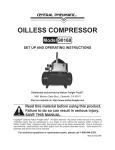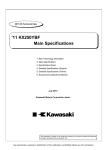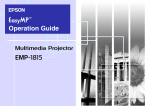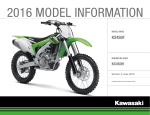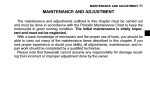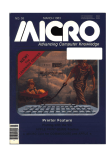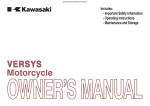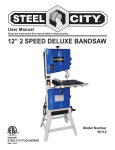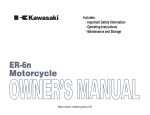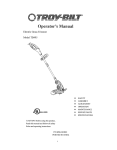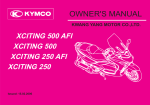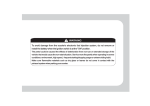Download Motorcycle Assembly & Preparation Manual
Transcript
KX450F Motorcycle Assembly & Preparation Manual Foreword In order to ship Kawasaki vehicles as efficiently as possible, they are partially disassembled before crating. Since some of the most commonly removed parts have a direct bearing on a vehicle’s reliability and safety, conscientious pre-sale assembly and preparation becomes extremely important. Good setup procedures can prevent needless warranty claims and give customers a greater sense of confidence in Kawasaki and their Kawasaki Dealers. This Assembly and Preparation Manual explains step by step procedures of the following items for the Kawasaki KX450F. 1. Uncrating 2. Assembly 3. Preparation The selling dealer assumes sole responsibility for any unauthorized modifications prior to sale. Refer to your Service Binder for any Service Bulletins specifying Factory Directed Modifications (Special Claims) which must be performed before the vehicle is ready for sale. Whenever you see the following symbols heed their instructions! Always follow safe operating and maintenance practices. © 2012 Kawasaki Heavy Industries, Ltd. DANGER DANGER indicates a hazardous situation which, if not avoided, will result in death or serious injury. WARNING WARNING indicates a hazardous situation which, if not avoided, could result in death or serious injury. NOTICE NOTICE is used to address practices not related to personal injury. NOTE ○This note symbol indicates points of particular interest for more efficient and convenient operation. Kawasaki Heavy Industries, Ltd. accepts no liability for any inaccuracies or omissions in this publication, although every possible measure has been taken to make it as complete and accurate as possible. All procedures and specifications subject to change without notice. May, 2012 Table of Contents Uncrating ...................................................................................... Opening Crate ............................................................................. Parts Check ................................................................................. Assembly ...................................................................................... Handlebar.................................................................................... Throttle Grip Assembly ................................................................ Front Brake Master Cylinder ....................................................... Clutch Lever Assembly................................................................ Launch Control Mode Button....................................................... Engine Stop Switch ..................................................................... Cables and Wiring Routing.......................................................... Front Fender................................................................................ Front Number Plate ..................................................................... Fuel Tank Breather Hose............................................................. Side Stand................................................................................... Brake Disc Cleaning .................................................................... Radiator Drain Hose .................................................................... Preparation ................................................................................... Air Cleaner ................................................................................. Front Brake.................................................................................. Rear Brake .................................................................................. Clutch Lever and Cable ............................................................... Drive Chain.................................................................................. Front Fork .................................................................................... Rear Shock Absorber .................................................................. Tire Air Pressures........................................................................ Fuel ............................................................................................. Coolant ........................................................................................ Engine Oil (4-stroke) ................................................................... Throttle Grip and Cable ............................................................... Idle Speed Adjustment ................................................................ Fastener Check ........................................................................... Standard Torque Table ................................................................ Test Ride the Motorcycle ............................................................. A&P Check List ........................................................................... 3 3 6 9 9 10 10 11 11 11 12 12 12 13 13 13 14 14 14 15 17 18 18 20 22 24 24 24 25 26 27 30 32 32 32 UNCRATING 3 Uncrating the vertical strut mounting bolts (D = • Remove 8, L = 12) and the vertical struts at both left and right sides, and discard them. Opening Crate WARNING Crates have sharp edges and may have nails or screws that can cause cuts and injury. Always wear protective gloves, boots and eye protection when uncrating to prevent injury. A. B. C. D. Top Frame Vertical Strut Mounting Bolts (D = 8, L = 12) Bottom Frame NOTICE When removing the vertical struts at both left and right sides, do not damage the radiator shrouds. WARNING The steel crate panel plates and fasteners have sharp edges. Always wear protective gloves, boots and eye protection when uncrating to prevent injury. a space about 6 m (20 ft) square to give • Clear yourself plenty of space to work. the crate upright on its base. • Place the cardboard cover. • Remove Remove • parts box.the handlebar, front fender, and the NOTICE When removing the crate bracket from the motorcycle, be careful not to drop any parts or the bracket onto the fuel tank and other components, and not to scratch the fuel tank or other components with the crate bracket. the crate bolts (D = 8, L = 12) to take • Remove off the crate bracket and discard them. A. Crate Bolts (D = 8, L = 12) B. Crate Bracket NOTICE Be careful that the motorcycle does not fall over. out all the bolts and screws and remove • Take the top frame, and front and rear frame of the • crate. Remove the rubber plug (dummy) on each fork top plug and discard them. 4 UNCRATING A. Rubber Plug (Dummy) B. Fork Top Plug the air valve adapter (see No.22 part in • Install the Parts Check section). ○When the air valve adapter. • Remove the air valve plug (see No.25 part in • Install the Parts Check section) and tighten it to the specified torque. Torque : 0.2 N·m (0.020 kgf·m, 1.8 in·lb) NOTE using the air valve adapter, apply grease to the O-ring. A. Air Valve Plug NOTICE A. Air Valve Adapter the front wheel off the ground using a • Raise jack (special tool: 57001-1238) and attach- • • ment (special tool: 57001-1608) or chain block. Prepare the commercially available suitable hand air pump and air pressure gauge. Using a commercially available suitable hand air pump and air pressure gauge, charge each fork with air [240 kPa (2.4 kgf/cm², 35 psi)] alternately beforehand. Be sure to install the air valve plug to prevent dust from entering. sure to remove the styrene foam on the • Be steering stem. NOTICE Do not pressurize the fork to more than 500 kPa (5.0 kgf/cm², 73 psi) or the fork may be damaged. The air pressure in each fork is different depending on gravity. Be sure to check and adjust the air pressure in each fork. A. Styrene Foam UNCRATING 5 This page intentionally left blank. 6 UNCRATING Parts Check the parts box, and check the parts against the illustrations. There may be minor differences • Open between these illustrations and the actual vehicle parts. In the following charts under Remarks, D = diameter in millimeters, and L = length in millimeters. UNCRATING 7 No. 1 2 3 4 5 6 7 8 9 10 11 12 13 14 15 16 17 18 19 20 21 22 23 24 25 Part Name DFI Setting Data Selection Connector DFI Setting Data Selection Connector Handlebar Pad Handlebar with Grip and Wiring Band Handlebar Clamp Bolt Clamp, Front Brake Master Cylinder Clamp Bolt, Front Brake Master Cylinder Flanged Bolt, Front Fender Front Fender Screw, Engine Stop Switch Screw, Launch Control Mode Button Clamp, Clutch Lever Handlebar Clamp Clamp, Engine Stop Switch Clamp, Launch Control Mode Button Clamp Bolt, Clutch Lever Fuel Tank Breather Hose Front Number Plate Flanged Bolt, Front Number Plate Spark Plug Wrench Spoke Nipple Wrench Air Valve Adapter, Front Fork Side Stand Owner’s Manual Air Valve Plug, Front Fork Qty 1 1 1 1 4 1 2 4 1 1 1 1 2 2 2 2 1 1 1 1 1 1 1 1 2 Remarks White Black RENTHAL RENTHAL D = 8, L = 35 D = 6, L = 18.5 D=3 D=4 D = 5, L = 16 L = 300 D = 6, L = 12 8 UNCRATING Spare Parts parts and their part numbers are subject to change without prior notice according to the model • These year. No. 1 2 3 4 5 6 7 8 9 Part Name Gasket, Cylinder Head, T = 0.65 Gasket, Cylinder Head Cover Gasket, Cylinder Base Gasket, Exhaust Pipe Gasket, Clutch Inner Cover Gasket, Clutch Outer Cover Gasket, Magneto Cover Gasket, Muffler, D = 53, L = 32 O-Ring, Oil Filter Cap Qty 2 2 2 2 2 2 2 2 2 Part Number 11004-0088 11061-0351 11061-0768 11061-0082 11061-0453 11061-0259 11061-0452 11061-0434 92055-1577 ASSEMBLY 9 Assembly Handlebar 2-stroke oil to the edge (slash area) of • Apply the handlebar. A. 120 mm (4.72 in.) the throttle grip assy on the handlebar • Install and insert the handlebar fully into the grip. A. Throttle Grip Assy the handlebar on the handlebar holders. • Put Mount the handlebar clamps. • Apply 2-stroke to the handlebar clamp • bolts, and installoilthem. A. Handlebar B. Handlebar Holders C. Handlebar Clamps D. Clamp Bolts (D = 8, L = 35) E. Scales F. Forward tightening the bolts, check the handle• Before bar position. A. B. C=D Handlebar Clamps Align the center of the handlebar bridge with the center of the handlebar holders. The scales on both sides are the same in width. NOTE ○The handlebar angle position can be adjusted to suit your preference using the scales. the front and rear clamp bolts evenly • Tighten to the specified torque. Torque : 25 N·m (2.5 kgf·m, 18 ft·lb) sure that the gaps between the handle• Make bar holder and clamp is approximately equal in the front and rear side. 10 ASSEMBLY WARNING If the throttle grip contacts the end of the handlebar, the throttle will be difficult to turn and may not return fully when released, creating the possiblity of an accident resulting in serious injury or death. Do not push the throttle grip so far onto the handlebar that the inside of the grip contacts the end of the handlebar. A. Forward B. Gap Front Brake Master Cylinder the master cylinder with the clamp and • Install bolts on the handlebar. Throttle Grip Assembly the dust cover off the throttle case. • Slip Adjust of the throttle grip assy so • that thethejointposition line of the throttle case is vertical • to the handlebar. Tighten the mounting screws (D = 5, L = 20) to the specified torque. Torque : 3.8 N·m (0.39 kgf·m, 34 in·lb) and close the throttle grip to check if the • Open throttle operates properly. • Reinstall the dust cover. A. B. C. D. Front Brake Master Cylinder 176.95 mm (6.97 in.) Horizontal Line of Frame Align reserve tank cap to the horizontal line of frame sure that the master cylinder clamp is • Make installed with the “UP” mark facing up. the upper clamp bolt first, then the • Tighten lower bolt to the specified torque. Torque : 8.8 N·m (0.90 kgf·m, 78 in·lb) A. B. C. D. E. Dust Cover Throttle Case Joint Line Screws (D = 5, L = 20) Throttle Grip A. Clamp Bolts B. UP Mark ASSEMBLY 11 Clutch Lever Assembly the clutch lever with the clamp and • Install bolts (D = 5, L = 16) on the handlebar. • Tighten the clamp bolts. Engine Stop Switch the clamps to the engine stop switch. • Attach the engine stop switch assy between • Install the grip and clutch lever and tighten the screw • A. Clutch Lever Assy B. 160.5 mm (6.32 in.) C. Clamp Bolts (D = 5, L = 16) D. Horizontal Line of Frame E. 30° ±5° Launch Control Mode Button the wiring band temporarily from the • Remove handlebar. NOTE ○When installing the removed wiring band, refer to “Engine Stop Switch”. the clamps to the launch control mode • Attach button. the launch control mode button assy. • Install • Tighten the screw (D = 4, L = 14). A. Launch Control Mode Button B. Clamps C. Screw (D = 4, L = 14) D. 5 ∼ 10 mm (0.20 ∼ 0.39 in.) (D = 3, L = 14). Secure the engine stop switch and launch control mode button leads to the handlebar with the wiring band. A. Engine Stop Switch B. Clamps C. Screw (D = 3, L = 14) D. Launch Control Mode Button E. Wiring Band 12 ASSEMBLY Cables and Wiring Routing that the cables, wiring leads and hoses • Check are routed correctly. A. Front Fender B. Front Bolts (D = 6, L = 18.5) C. Rear Bolts (D = 6, L = 18.5) Front Number Plate Handlebar Pad Installation the handlebar pad onto the handlebar • Install bridge so that the characters on the pad are shown as “RENTHAL” when viewed from the front of the motorcycle. (Viewed from Front) A. Throttle Cables B. Wiring Band C. Engine Stop Switch Lead D. Launch Control Mode Button Lead E. Clutch Cable A. Handlebar Pad Front Number Plate Installation Front Fender the front fender between the fork legs • Position and fasten it to the steering stem base with four bolts (D = 6, L = 18.5). ○Temporarily NOTE install the front bolts first, and then the rear bolts. ○Tighten all bolts securely. the front number plate between the • Position brake hose and front fork, and fit the two holes of the number plate to the projections of the steering stem base. ASSEMBLY 13 A. Front Number Plate B. Holes C. Projections A. Fuel Tank Cap B. Breather Hose (L = 300) C. Hole the number plate to the stem head • Fasten with the flanged bolt (D = 6, L = 12). the number plate belt to the handlebar • Fasten pad with a latch. Side Stand A. Flanged Bolt (D = 6, L = 12) B. Number Plate Belt Usage: the flat bar end of the side stand into the • Fit rear axle shaft. A. Side Stand B. Rear Axle Shaft Fuel Tank Breather Hose one end of the breather hose into the fuel • Fit tank cap, and fit the other end into the hole of the steering shaft. NOTE ○Do not start the engine or attempt to ride the motorcycle when the side stand is installed. Brake Disc Cleaning the front and rear brake discs using • Clean oilless solvent. WARNING An anticorrosive treatment applied to the brake discs will increase braking distance and can cause an accident resulting in serious injury or death. Remove the anticorrosive treatment using an oilless solvent. 14 PREPARATION the foam air cleaner element for • Inspect proper oiling. foam air cleaner element is dry, remove • Ifthethewing bolt, and take out the air cleaner element. Radiator Drain Hose the radiator over flow hose end out of the • Pull engine guard. A. Wing Bolt B. Air Cleaner Element • Take the element off its holder. Preparation Air Cleaner Air Cleaner Element Inspection The foam cleaner element on off road models is oiled prior to shipping. However, over time the filter will dry and filtration performance will diminish. Remove the side cover bolts (left and right) (2) to remove the seat. A. Air Cleaner Element B. Holder the element with high-quality foam • Saturate air filter oil and make sure that the oil is evenly • • A. Bolt (D = 8, L = 16) B. Seat applied throughout the element. Squeeze out the excess oil, but do not wring the element as this could cause tearing. In this case, too much oil is better than too little. Finally pat the inside of the element with a paper towel to remove any excess oil. Install the element onto its holder, and coat the element lip and lip seat with a thick layer of all-purpose grease to assure a complete seal. PREPARATION 15 A. Apply grease. the air cleaner element so that its tab • Install faces upward and its projections align with the holes in the housing, and tighten the wing bolt, making sure that it is properly seated and sealed. A. Seat B. Front Hook C. Front Receiver D. Center Hook E. Center Receiver the side cover mounting bolts (left and • Tighten right). Front Brake Front Brake Fluid Level Inspection the front brake fluid reservoir held hori• With zontal, check that the fluid level is above the lower level line. A. Tab B. Projections C. Holes install the seat, align the front hook on the • To seat with front receiver on the fuel tank. Slide the seat forward so that center hook engages first followed by the front hook. A. Front Brake Fluid Reservoir B. Lower Level Line the fluid level in the reservoir is below the • Iflower level line, check for fluid leaks in the • front brake lines, and fill the reservoir. Remove the reservoir cap and diaphragm, and fill the reservoir to the upper level line with DOT4 brake fluid. 16 PREPARATION Brake Line Air Bleeding the reservoir cap and diaphragm, • Remove and check that there is plenty of fluid in the reservoir. NOTE ○The fluid level must be checked several times A. Front Brake Fluid Reservoir B. Upper Level Line WARNING When working with the disc brake, observe the precautions listed below. 1. Never reuse old brake fluid. 2. Do not use fluid from a container that has been left unsealed or that has been open for a long time. 3. Do not mix two types and brands of fluid for use in the brake. This lowers the brake fluid boiling point and could cause the brake to be ineffective. It may also cause the rubber brake parts to deteriorate. 4. Don’t leave the reservoir cap off for any length of time to avoid moisture contamination of the fluid. 5. Don’t change the fluid in the rain or when a strong wind is blowing. 6. Brake fluid quickly ruins painted surfaces; any spilled fluid should be completely wiped up immediately. 7. If any of the brake line fittings or the bleed valve is opened at any time, the AIR MUST BE BLED FROM THE BRAKE LINE. the diaphragm and reservoir cap. • Install Tighten the reservoir cap screws to the spec• ified torque. Torque : 1.5 N·m (0.15 kgf·m, 13 in·lb) the brake lever several times. • Operate it feels spongy, there might be air in the • Ifbrake line. If necessary, bleed the air in the front brake • lines. check for fluid leakage around the fit• Also tings. during the bleeding operation and replenished as necessary. If the fluid in the reservoir runs completely out any time during bleeding, the bleeding operation must be done over again from the beginning since air will have entered the line. a clear plastic hose to the bleed valve • Attach on the front brake caliper and run the other • • end of the hose into a container. With the reservoir cap off, slowly pump the brake lever several times until no air bubbles can be seen rising up through the fluid from the holes at the bottom of the reservoir. This bleeds the air from the brake master cylinder end of the line. Pump the brake lever a few times until it becomes hard and then, holding the lever squeezed, quickly open (turn counterclockwise) and close the bleed valve. Then release the lever. Repeat this operation until no more air can be seen coming out into the plastic hose. A. Hold the brake lever applied. B. Quickly open and close the bleed valve. C. Release the brake lever. air bleeding is finished, check that the • When fluid level is between the upper and lower • • level lines. Install the diaphragm and reservoir cap. Tighten the bleed valve to the specified torque. Torque : 7.8 N·m (0.80 kgf·m, 69 in·lb) PREPARATION 17 the brake forcefully for a few seconds, • Apply and check for fluid leakage around the fittings. Rear Brake Rear Brake Fluid Level Inspection the rear brake fluid reservoir positioned • With horizontally, check that the fluid level is above the lower level line. the brake pedal several times. • Operate If it feels • brake line.spongy, there might be air in the • Ifline.necessary, bleed the air in the rear brake check for fluid leakage around the fit• Also tings. Brake Line Air Bleeding the reservoir cap and diaphragm, • Remove and check that there is plenty of fluid in the reservoir. NOTE ○The fluid level must be checked several times during the bleeding operation and replenished as necessary. If the fluid in the reservoir runs completely out any time during bleeding, the bleeding operation must be done over again from the beginning since air will have entered the line. A. Rear Brake Fluid Reservoir B. Lower Level Line the fluid level in the reservoir is below the • Iflower level line, check for fluid leaks in the • rear brake lines, and fill the reservoir. Remove the reservoir cap and diaphragm, and fill the reservoir to the upper level line with DOT4 brake fluid. a clear plastic hose to the bleed valve • Attach on the rear brake caliper and run the other • • end of the hose into a container. With the reservoir cap off, slowly pump the brake pedal several times until no air bubbles can be seen rising up through the fluid from the holes at the bottom of the reservoir. This bleeds the air from the rear brake master cylinder end of the line. Pump the brake pedal a few times until it becomes hard and then, holding the pedal pushed down, quickly open (turn counterclockwise) and close the bleed valve. Then release the pedal. Repeat this operation until no more air can be seen coming up into the plastic hose. A. Rear Brake Fluid Reservoir B. Upper Level Line the diaphragm and reservoir cap. • Install Tighten the reservoir cap screws to the spec• ified torque. Torque : 1.5 N·m (0.15 kgf·m, 13 in·lb) A. Hold the brake pedal applied. B. Quickly open and close the bleed valve. C. Release the brake pedal. 18 PREPARATION air bleeding is finished, check the fluid • When level. the diaphragm and reservoir cap. • Install Tighten • torque. the bleed valve to the specified Torque : 7.8 N·m (0.80 kgf·m, 69 in·lb) the brake forcefully for a few seconds, • Apply and check for fluid leakage around the fittings. Clutch Lever and Cable Clutch Lever Free Play Inspection that the clutch lever has the specified • Check amount of free play. Clutch Lever Free Play: 8 ∼ 13 mm (0.3 ∼ 0.5 in.) A. Dust Cover B. Locknut C. Adjuster the locknut and slide the dust cover • Tighten back in place. NOTE ○After the adjustment is made, start the engine and check that the clutch does not slip and that it releases properly. ○For minor corrections, use the adjuster at the clutch lever. Drive Chain A. Clutch Lever B. Adjuster C. 8 ∼ 13 mm (0.3 ∼ 0.5 in.) Drive Chain Slack and Wheel Alignment Inspection the motorcycle up on its side stand. • Set Make sure that the drive chain has the speci• fied amount of play, and that the left and right notches are on the same marks or points on the left and right of the swingarm. the free play is incorrect, adjust the free • Ifplay. WARNING Clutch Lever Free Play Adjustment the adjuster so that the clutch lever will • Turn have 8 ∼ 13 mm (0.3 ∼ 0.5 in.) of free play. it cannot be done, use the adjuster on the • Ifmiddle of the cable as follows. Turn the in all the way. • Slide the adjuster cover. • Loosen thedust locknut middle (upper end) • of the clutch cable,onandtheturn the adjuster so that the clutch lever play is 8 ∼ 13 mm (0.3 ∼ 0.5 in.). Misalignment of the wheel will result in abnormal tire wear and can cause an unsafe riding condition. Be sure the wheel is properly aligned. the rear wheel off the ground, rotate the • Raise rear wheel to find the place where the chain • is tightest (because it wears unevenly). Push up the drive chain in the middle of the upper chain run to measure the chain slack. The distance between the chain and the swingarm (at the end of the chain slipper) should be 52 ∼ 58 mm (2.0 ∼ 2.3 in.). Drive Chain Slack: 52 ∼ 58 mm (2.0 ∼ 2.3 in.) PREPARATION 19 the chain is too loose, turn out the left and • Ifright chain adjusting bolts evenly. the chain is too tight, turn in the left and right • Ifchain adjusting bolts evenly. Turn out both chain adjusting bolts evenly un• til the drive chain has the correct amount of slack. To keep the chain and wheel properly aligned, the chain adjuster notches should align with the same marks in each side of the swingarm. NOTE A. 52 ∼ 58 mm (2.0 ∼ 2.3 in.) ○Wheel alignment can also be checked using the straightedge or string method. the drive chain if its slack is out of spec• Adjust ification. WARNING Misalignment of the wheel will result in abnormal tire wear and can cause an unsafe riding condition. Be sure the wheel is properly aligned. WARNING A chain that breaks or jumps off the sprockets could snag on the engine sprocket or lock the rear wheel, severely damaging the motorcycle and causing it to go out of control. Inspect the chain for damage and proper adjustment. Drive Chain Slack Adjustment the cotter pin, and loosen the rear • Remove axle nut. the left and right chain adjuster lock• Loosen nuts. both chain adjuster locknuts. • Tighten Tighten • torque. the rear axle nut to the specified Torque : 108 N·m (11.0 kgf·m, 80 ft·lb) the wheel, measure the chain slack • Rotate again at the tightest position, and readjust if • necessary. Install a new cotter pin. NOTE ○When inserting the cotter pin, if the slots in the nut do not align with the cotter pin hole in the axle, tighten the nut clockwise up to the next alignment. ○It should be within 30 degrees. ○Loosen once and tighten again when the slot goes past the nearest hole. A. Rear Axle Nut B. Chain Adjusting Bolt C. Chain Adjuster Locknut D. Marks E. Notch F. Cotter Pin A. Cotter Pin B. Turning Clockwise • Bend the cotter pin over the nut. 20 PREPARATION ○When NOTE using the air valve adapter, apply grease to the O-ring. A. Cotter Pin B. Nut WARNING A loose axle nut can lead to an accident resulting in serious injury or death. Tighten the axle nut to the proper torque and be sure the cotter pin is installed correctly. • Check the rear brake effectiveness. Front Fork Air Pressure Adjustment Before riding, adjust the air pressure to the specific value. Raise the front wheel off the ground using a jack (special tool: 57001-1238) and attachment (special tool: 57001-1608). Prepare the commercially available suitable hand air pump and air pressure gauge. Remove the air valve plug from the front fork top plug. • • • A. Air Valve Adapter a commercially available suitable hand • Using air pump and air pressure gauge, adjust the air pressure in each fork leg to the specified value. Air Pressure: 240 kPa (2.4 kgf/cm², 35 psi) NOTE ○Do not use the side stand during air pressure adjustment. WARNING When riding and transporting the motorcycle, make sure that the air pressure is within the adjustable range. If used outside the adjustable range, running stability can decrease and cause an accident resulting in serious injury or death. Be sure to remove the air valve adapter before riding. If the air valve adapter is damaged by a stone during riding, air leakage can cause loss of control and an accident resulting in serious injury or death. NOTICE Do not pressurize the fork to more than 500 kPa (5.0 kgf/cm², 73 psi) or the fork may be damaged. The right and left fork tubes must be adjusted evenly. A. Air Valve Plug B. Front Fork Top Plug • Install the air valve adapter. PREPARATION 21 NOTICE The right and left fork tubes must be adjusted evenly. NOTICE Do not force to turn the compression damping adjuster from the fully seated position or the adjusting mechanism may be damaged. • • After air pressure adjustment, remove the air valve adapter. Reinstall the air valve plug and tighten it to the specified torque. Compression Damping Settings Torque : 0.2 N·m (0.020 kgf·m, 1.8 in·lb) NOTICE Be sure to install the air valve plug to prevent dust from entering. delivery to the customer, explain to • Before a customer about the proper use of the air valve adapter while showing the corresponding page (Title: Front Suspension) in the Owner’s Manual. Compression Damping Adjustment the position of the compression damp• Check ing adjusters on the top of the fork tubes. STD Compression Damping: 11 clicks (Counterclockwise from the fully seated position) A. Seated Position (Adjuster turned fully clockwise) B. Softer (Counterclockwise) C. Harder (Clockwise) D. Standard Setting *: Number of turns counterclockwise usable range 22 clicks or more. Rebound Damping Adjustment the bottom of the fork tubes. • Clean Check of the rebound damping • adjusterstheatposition the bottom of the fork tubes. STD Rebound Damping: 9 clicks (Counterclockwise from the fully seated position) A. Compression Damping Adjuster adjust the compression damping, turn the • To adjuster on each front fork base valve assembly with a standard tip screwdriver. Adjust the compression damping to the standard setting position. A. Rebound Damping Adjuster 22 PREPARATION adjust the rebound damping, turn the ad• To juster on each front fork cylinder valve with a adjust the high speed compression damp• To ing, turn the adjuster all the way clockwise standard tip screwdriver. Adjust the rebound damping to the standard setting position. with a wrench to make damping greatest. Turn the adjuster counterclockwise to decrease damping. Adjust the high speed compression damping to the standard position. NOTICE The right and left fork tubes must be adjusted evenly. • NOTICE Do not force to turn the rebound damping adjuster from the fully seated position or the adjusting mechanism may be damaged. Rebound Damping Settings A. High Speed Compression Damping Adjuster B. Wrench NOTICE Do not force to turn the compression damping adjuster from the fully seated position or the adjusting mechanism may be damaged. A. Seated Position (Adjuster turned fully clockwise) B. Softer (Counterclockwise) C. Harder (Clockwise) D. Standard Setting High Speed Compression Damping Settings *: Number of turns counterclockwise usable range 20 clicks or more. Rear Shock Absorber Compression Damping Adjustment There are two adjustments you can make to rear shock absorber gas reservoir. Check the position of the high and low speed compression damping adjusters on the gas reservoir at the upper end of the rear shock absorber. • STD High Speed Compression Damping: For European Model 1 1/2 turns out (Counterclockwise from the fully seated position) For Australian Model 1 3/4 turns out (Counterclockwise from the fully seated position) A. Seated Position (Adjuster turned fully clockwise) B. Softer (Counterclockwise) C. Harder (Clockwise) D. Standard Setting for European Model E. Standard Setting for Australian Model PREPARATION 23 *: Number of turns counterclockwise usable range 2 turns or more. *: Number of turns counterclockwise usable range 22 clicks or more. STD Low Speed Compression Damping: Rebound Damping Adjustment For European Model 11 clicks (Counterclockwise from the fully seated position) For Australian Model 8 clicks (Counterclockwise from the fully seated position) adjust the low speed compression damp• To ing, turn the adjuster all the way clockwise • with a standard tip screwdriver to make the damping greatest. Turn the adjuster counterclockwise to decrease damping. Adjust the low speed compression damping to the standard position. the position of the rebound damping • Check adjuster at the bottom of the rear shock absorber. STD Rebound Damping: For European Model 20 clicks (Counterclockwise from the fully seated position) For Australian Model 19 clicks (Counterclockwise from the fully seated position) A. Rebound Damping Adjuster A. Low Speed Compression Damping Adjuster B. Screwdriver Low Speed Compression Damping Settings adjust the rear shock absorber rebound • To damping, turn the rebound damping adjuster at the bottom of the rear shock absorber with a standard tip screwdriver. Adjust the rebound damping to the standard setting position. NOTICE Do not force to turn the rebound damping adjuster from the fully seated position or the adjusting mechanism may be damaged. A. Seated Position (Adjuster turned fully clockwise) B. Softer (Counterclockwise) C. Harder (Clockwise) D. Standard Setting for European Model E. Standard Setting for Australian Model 24 PREPARATION Rebound Damping Adjuster Settings Fuel WARNING A. Seated Position (Adjuster turned fully clockwise) B. Softer (Counterclockwise) C. Harder (Clockwise) D. Standard Setting for European Model E. Standard Setting for Australian Model *: Number of turns counterclockwise usable range 33 clicks or more. Tire Air Pressures prevent flat-spotting during shipment, the • To tires are over-inflated before crating. Adjust the pressures to the specified values in the front and rear, and make sure to tighten the caps securely. Tire Air Pressure [when cold]: Front: Rear: 100 kPa (1.0 kgf/cm², 14 psi) 100 kPa (1.0 kgf/cm², 14 psi) Gasoline is extremely flammable and can be explosive under certain conditions, creating the potential for serious burns. Do not smoke. Make sure the area is well ventilated and free from any source of flame or sparks; this includes any appliance with a pilot light. Never fill the tank completely to the top. If the tank is filled completely to the top, heat may cause the fuel to expand and overflow through the vent in the tank cap. After refueling, make sure the tank cap is closed securely. If gasoline is spilled on the fuel tank, wipe it off immediately. the fuel tank cap, and check for debris • Open in the fuel tank. the fuel tank with one gallon or four liters • Fill of unleaded gasoline. Use a gasoline with a minimum octane rating shown below. Use clean, fresh unleaded gasoline with an octane rating equal to or higher than that shown in the table. Fuel Type Unleaded Gasoline Minimum Research Octane Number (RON) Octane Rating 95 the fuel tank cap, and check for any • Close leaks. Coolant ○The NOTE coolant originally filled into the cooling system contains 50% of a permanent, ethylene-glycol-based antifreeze, has a freezing point of –35°C (–31°F) and a green appearance. Coolant Level Inspection the motorcycle slightly so that the filler • Lean neck is located uppermost. the radiator cap in two steps. • Remove turn the cap counterclockwise to the first • First, stop and wait there for a few seconds. push and turn the cap further in the • Then, same direction and remove it. PREPARATION 25 NOTE ○This vehicle’s engine is filled with 10W-40 oil from the factory. DO NOT DRAIN and refill the crankcase before use. Check oil level and drain bolts tightness. Engine Oil Drain Bolts Torque: (M10) 20 N·m (2.0 kgf·m, 15 ft·lb) (M6) 7.0 N·m (0.71 kgf·m, 62 in·lb) A. Radiator Cap the coolant level in the radiator. The • Check coolant should come up to the bottom of the radiator filler neck. ○Check NOTE the coolant level when the engine is cold (room or ambient temperature). A. Engine Oil Drain Bolt (M10) B. Engine Oil Drain Bolt (M6) the oil level by placing the motorcycle • Check on its wheels and leveling it from front to back and side to side. When level, the oil level should be between the upper and lower lines indicated next to the oil level inspection window. A. Coolant Level B. Filler Neck ○Tipping the motorcycle from side to side by just a few degrees can drastically alter the oil level indicated in the oil level inspection window. Be sure the unit is upright when checking the level. coolant level is low, add coolant through • Ifthetheradiator filler opening to the bottom of the • filler neck. Install the radiator cap. Verify Engine Oil Presence no oil appears in the oil level inspection win• Ifdow, tip the motorcycle slightly to the right un- Engine Oil (4-stroke) Because of the semi-dry sump lubrication system, the engine oil level indicated on the oil level inspection window will fluctuate depending on the motorcycle’s position and engine speed when the engine shut off. To ensure a proper reading of the engine oil level, follow the Engine Oil Level Inspection procedures closely. When performing Assembly and Preparation, use the following procedures to verify that the engine oil level is correct. NOTE • til oil is visible then return to an upright position. If no oil appears even when tipped at an extreme angle, remove the drain bolts to empty any oil that may be in the transmission and crankcase, reinstall the drain bolts and refill with the specified amount of oil. If oil appears in the glass when the machine is tipped but is not visible when perpendicular, you must verify the oil level after the engine has been run. NOTICE If the engine is run without oil, it will be severely damaged. 26 PREPARATION Engine Oil Level Inspection • • After you have verified that the engine contains oil, start the engine, allow it to idle for several minutes then shut it off. DO NOT REV THE ENGINE AND SHUT IT OFF AT HIGH RPM. Doing so can leave a significant amount of oil in the crank room and top end, leading to a false oil level reading. Allow the oil to settle by keeping the motorcycle upright on its wheels for several minutes. Check the engine oil level with the motorcycle vertical through the oil level inspection window on the lower right side of the engine. The engine oil level should come up between the upper and lower level lines next to the oil level inspection window. Recommended Engine Oil Type: Castrol “POWER1 R4 Racing” SAE 5W-40 or API SG, SH, SJ, SL or SM with JASO MA, MA1 or MA2 Viscosity: SAE 10W-30, 10W-40, 10W-50 Capacity: 0.96 L (1.01 US qt) [when filter is not removed] 0.98 L (1.04 US qt) [when filter is removed] The oil viscosity may need to be changed to accommodate atmospheric conditions in your riding area. NOTE ○Do not add any chemical additive to the oil. Oils fulfilling the above requirements are fully formulated and provide adequate lubrication for both the engine and the clutch. A. Oil Level Inspection Window B. Upper Level Line C. Lower Level Line D. Oil Filler Cap level is too high, open the oil filler • Ifcaptheandoilremove the excess oil through the oil • • filler opening, using a syringe or some other suitable device. If the oil level is too low, add oil through the oil filler opening to reach the correct level. Use the same type of oil that is already in the engine. Before reinstalling the cap, be sure to replace the O-ring in it with a new one. Throttle Grip and Cable Throttle Grip Free Play Inspection the throttle grip free play. If the free • Check play is incorrect, adjust the throttle cable. Throttle Grip Free Play: 2 ∼ 3 mm (0.08 ∼ 0.12 in.) that the throttle grip moves smoothly • Check from full open to close, and the throttle closes quickly and completely in all steering positions by the return spring. If the throttle grip does not return properly, check the throttle cable routing, grip free play, and for possible cable damage. Then lubricate the throttle cable. PREPARATION 27 Idle Speed Adjustment the engine and warm it up thoroughly. • Start the idle speed, using the engine rev• Inspect olution tester for high accuracy. the idle speed to following range by • Adjust turning the idle adjusting screw/choke knob. Idle Speed: 1 950 ∼ 2 050 r/min (rpm) A. Throttle Grip B. 2 ∼ 3 mm (0.08 ∼ 0.12 in.) the engine at idle speed and turn the • Run handlebar all the way to the right and left to ensure that the idle speed does not change. If the idle speed increases, check the throttle grip free play and the cable routing. WARNING Operation with improperly adjusted, incorrectly routed or damaged cables could result in an unsafe riding condition. Follow the service manual to make sure to correct any of these conditions. Throttle Grip Free Play Adjustment the locknut of the accelerator cable • Loosen and turn the adjuster to give the throttle grip • plenty of play. Tighten the locknut securely. A. Adjuster B. Locknut C. Accelerator Cable A. Idle Adjusting Screw/Choke Knob B. Tester and close the throttle grip a few times • Open to make sure that the idle speed is within the • specified range. With the engine idling, turn the handlebar to each side. If handlebar movement changes the idle speed, check the throttle cable routing and free play. WARNING Operation with incorrectly routed or damaged throttle cable could result in an unsafe riding condition. Be sure the throttle cable is routed correctly, properly adjusted and is not damaged in any way. 28 PREPARATION NOTICE This motorcycle is designed for competition use only. Therefore, the radiator does not incorporate a coolant reserve tank or cooling fan. Prolonged idling of the engine with no airflow through the radiator can cause coolant loss and engine overheating resulting in possible engine damage. Any riding conditions that increase engine temperature will further reduce idling time before coolant loss occurs. These conditions include high ambient temperature, sandy or muddy terrain, or other conditions causing high engine loads at low speeds. Furthermore, warming the engine up excessively before operation, or leaving idling with the hot engine temperature after operation results in the engine overheating, too. for any exhaust leaks and correct if • Check necessary. PREPARATION 29 This page intentionally left blank. 30 PREPARATION Fastener Check torque values listed are for assembly and preparation items only, see the appropriate Service • The Manual for a more comprehensive list. Check tightness of all fasteners that are in the table before retail delivery. Also check to see that each cotter pin or circlip is in place. PREPARATION 31 No. Fastener Steering 1 Handlebar clamp bolts Brake 2 Front master cylinder clamp bolts 3 Front caliper mounting bolts 4 Front caliper bleed valve 5 Rear master cylinder mounting bolts 6 Rear caliper bleed valve Wheel 7 Front axle nut 8 Front axle clamp bolts (Left and Right) Suspension 9 Front fork clamp bolts (Upper) 10 Front fork clamp bolts (Lower) 11 Rear shock absorber mounting nut (Upper) 12 Rear shock absorber mounting nut (Lower) 13 Swingarm pivot shaft nut 14 Tie-rod mounting nuts 15 Rocker arm pivot nut Engine Oil Drain Bolt 16 Engine oil drain bolt (M10) 17 Engine oil drain bolt (M6) Cotter Pin or Circlip 18 Rear axle nut cotter pin 19 Rear master cylinder cotter pin 20 Footpeg cotter pin (Left and Right) N·m Torque kgf·m ft·lb Remarks 25 2.5 18 2T, AL 8.8 25 7.8 9.8 7.8 0.90 2.5 0.80 1.0 0.80 78 in·lb 18 69 in·lb 87 in·lb 69 in·lb S 78 20 8.0 2.0 58 15 S AL, S 20 20 39 34 98 59 59 2.0 2.0 4.0 3.5 10 6.0 6.0 15 15 29 25 72 43 43 AL AL 20 7.0 2.0 0.71 15 62 in·lb – – – – – – – – – AL: Tighten the two clamp bolts alternately two times to ensure even tightening torque. S: Follow the specified tightening sequence. (Tighten the upper clamp bolt first, and then the lower clamp bolt.) 2T: Apply 2-stroke oil. 32 PREPARATION Standard Torque Table This table relating tightening torque to thread diameter, lists the basic torque for bolts and nuts. Use this table for only the bolts and nuts which do not require a specific torque value. All of the values are for use with dry solvent -cleaned threads. General Fasteners: Threads dia. mm 5 6 8 10 12 14 16 18 20 N·m 3.4 ∼ 4.9 5.9 ∼ 7.8 14 ∼ 19 25 ∼ 34 44 ∼ 61 73 ∼ 98 115 ∼ 155 165 ∼ 225 225 ∼ 325 Torque kgf·m 0.35 ∼ 0.50 0.60 ∼ 0.80 1.4 ∼ 1.9 2.6 ∼ 3.5 4.5 ∼ 6.2 7.4 ∼ 10.0 11.5 ∼ 16.0 17.0 ∼ 23.0 23.0 ∼ 33.0 ft·lb 30 ∼ 43 in·lb 52 ∼ 69 in·lb 10.0 ∼ 13.5 19.0 ∼ 25.0 33 ∼ 45 54 ∼ 72 83 ∼ 115 125 ∼ 165 165 ∼ 240 Test Ride the Motorcycle • Complete the test ride check list. Control Cables: Throttle cable must work without binding in any steering position. Steering: Action is free from lock–to–lock. Suspension: Check operation front and rear. Engine: Kick starter works properly and engine starts promptly. Good throttle response and return. Transmission and Clutch: Smooth operation. Brake: Adequate, smooth stopping power, No drag. Engine Stop Switch Works: Launch Control Mode Button Works: 1. Start the engine. 2. Shift into neutral, 1st, or 2nd gear. 3. Push the launch control mode button for over two seconds. 4. The orange launch control mode indicator light (LED) will blink to indicate the system is operating. 5. When shifting into 3rd, the system is deactivated automatically and the indicator light stops blinking. No Unusual Noises: No Fuel and Oil, Brake Fluid, or Coolant Leaks: PREPARATION COMPLETE. A&P Check List • Complete the A&P Check List. MODEL APPLICATION Year 2013 Model KX450FD Name KX450F Part No. 99939-1344-01




































